An Examination of Innovative Curriculum Approaches: The New Basics
VerifiedAdded on 2021/02/20
|8
|1590
|91
Essay
AI Summary
This essay provides an in-depth analysis of innovative curriculum approaches, specifically focusing on the New Basics Project. It explores key elements such as literacy, problem-solving, and technology integration, highlighting the role of rich tasks in fostering critical thinking and student engagement. The essay examines the implications of this curriculum for teachers, including its impact on assessment, feedback, and the development of future learning programs. It also discusses the elements of the New Basics curriculum and its relevance to future educational practices, emphasizing the importance of trans-disciplinary learning and real-world problem-solving. The essay references various sources to support its arguments, offering a comprehensive overview of the subject matter and its significance in the evolving landscape of education.
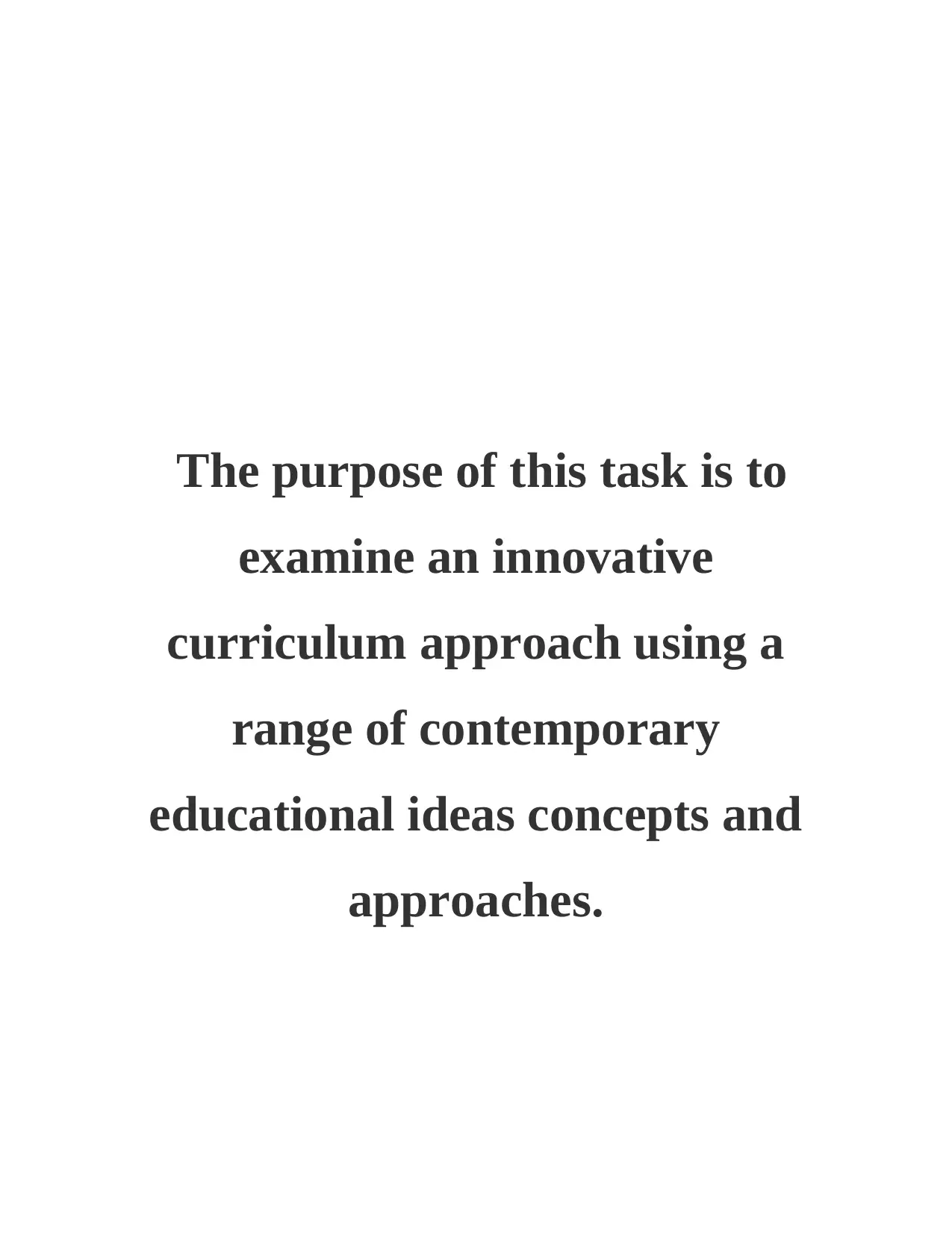
The purpose of this task is to
examine an innovative
curriculum approach using a
range of contemporary
educational ideas concepts and
approaches.
examine an innovative
curriculum approach using a
range of contemporary
educational ideas concepts and
approaches.
Paraphrase This Document
Need a fresh take? Get an instant paraphrase of this document with our AI Paraphraser
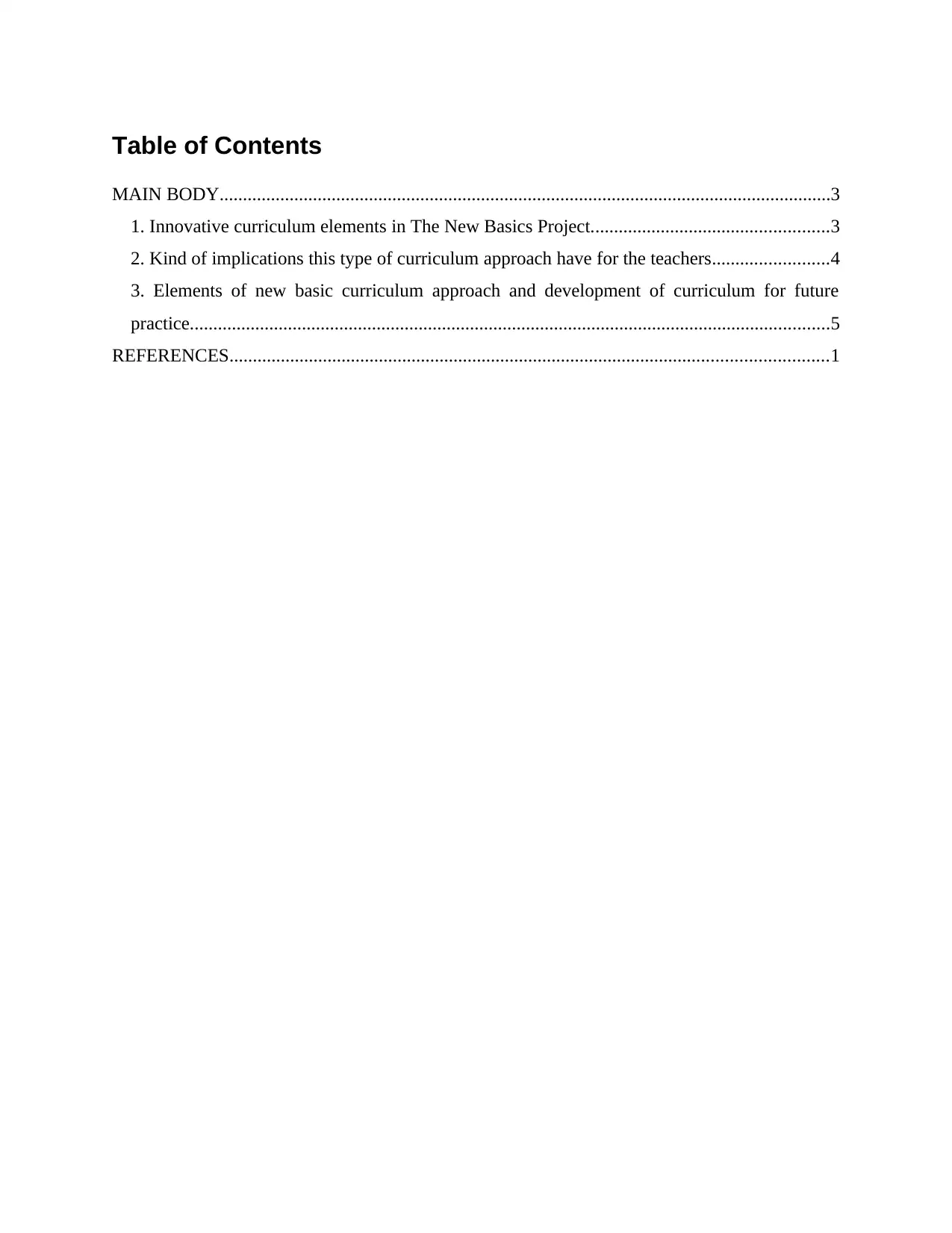
Table of Contents
MAIN BODY...................................................................................................................................3
1. Innovative curriculum elements in The New Basics Project...................................................3
2. Kind of implications this type of curriculum approach have for the teachers.........................4
3. Elements of new basic curriculum approach and development of curriculum for future
practice.........................................................................................................................................5
REFERENCES................................................................................................................................1
MAIN BODY...................................................................................................................................3
1. Innovative curriculum elements in The New Basics Project...................................................3
2. Kind of implications this type of curriculum approach have for the teachers.........................4
3. Elements of new basic curriculum approach and development of curriculum for future
practice.........................................................................................................................................5
REFERENCES................................................................................................................................1
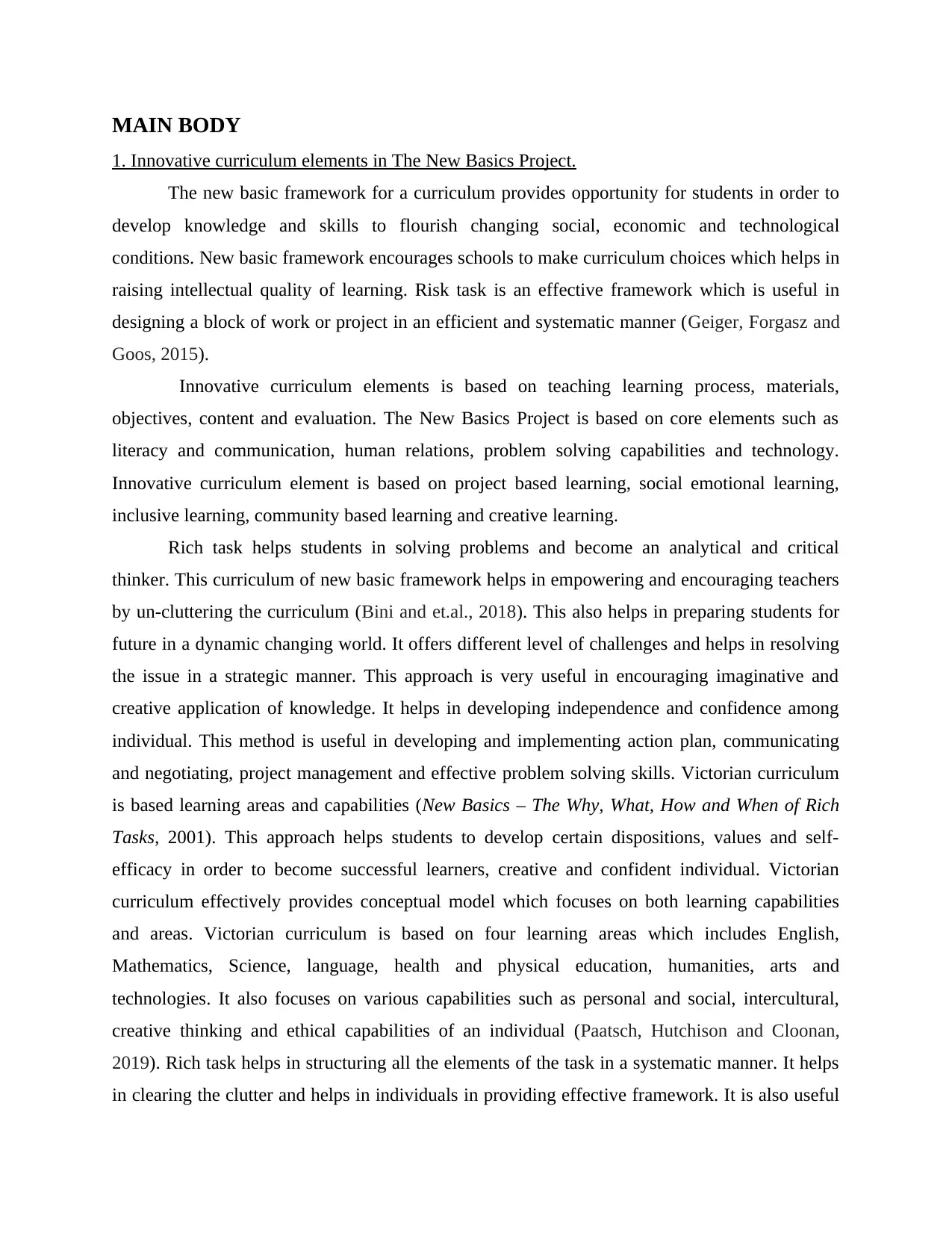
MAIN BODY
1. Innovative curriculum elements in The New Basics Project.
The new basic framework for a curriculum provides opportunity for students in order to
develop knowledge and skills to flourish changing social, economic and technological
conditions. New basic framework encourages schools to make curriculum choices which helps in
raising intellectual quality of learning. Risk task is an effective framework which is useful in
designing a block of work or project in an efficient and systematic manner (Geiger, Forgasz and
Goos, 2015).
Innovative curriculum elements is based on teaching learning process, materials,
objectives, content and evaluation. The New Basics Project is based on core elements such as
literacy and communication, human relations, problem solving capabilities and technology.
Innovative curriculum element is based on project based learning, social emotional learning,
inclusive learning, community based learning and creative learning.
Rich task helps students in solving problems and become an analytical and critical
thinker. This curriculum of new basic framework helps in empowering and encouraging teachers
by un-cluttering the curriculum (Bini and et.al., 2018). This also helps in preparing students for
future in a dynamic changing world. It offers different level of challenges and helps in resolving
the issue in a strategic manner. This approach is very useful in encouraging imaginative and
creative application of knowledge. It helps in developing independence and confidence among
individual. This method is useful in developing and implementing action plan, communicating
and negotiating, project management and effective problem solving skills. Victorian curriculum
is based learning areas and capabilities (New Basics – The Why, What, How and When of Rich
Tasks, 2001). This approach helps students to develop certain dispositions, values and self-
efficacy in order to become successful learners, creative and confident individual. Victorian
curriculum effectively provides conceptual model which focuses on both learning capabilities
and areas. Victorian curriculum is based on four learning areas which includes English,
Mathematics, Science, language, health and physical education, humanities, arts and
technologies. It also focuses on various capabilities such as personal and social, intercultural,
creative thinking and ethical capabilities of an individual (Paatsch, Hutchison and Cloonan,
2019). Rich task helps in structuring all the elements of the task in a systematic manner. It helps
in clearing the clutter and helps in individuals in providing effective framework. It is also useful
1. Innovative curriculum elements in The New Basics Project.
The new basic framework for a curriculum provides opportunity for students in order to
develop knowledge and skills to flourish changing social, economic and technological
conditions. New basic framework encourages schools to make curriculum choices which helps in
raising intellectual quality of learning. Risk task is an effective framework which is useful in
designing a block of work or project in an efficient and systematic manner (Geiger, Forgasz and
Goos, 2015).
Innovative curriculum elements is based on teaching learning process, materials,
objectives, content and evaluation. The New Basics Project is based on core elements such as
literacy and communication, human relations, problem solving capabilities and technology.
Innovative curriculum element is based on project based learning, social emotional learning,
inclusive learning, community based learning and creative learning.
Rich task helps students in solving problems and become an analytical and critical
thinker. This curriculum of new basic framework helps in empowering and encouraging teachers
by un-cluttering the curriculum (Bini and et.al., 2018). This also helps in preparing students for
future in a dynamic changing world. It offers different level of challenges and helps in resolving
the issue in a strategic manner. This approach is very useful in encouraging imaginative and
creative application of knowledge. It helps in developing independence and confidence among
individual. This method is useful in developing and implementing action plan, communicating
and negotiating, project management and effective problem solving skills. Victorian curriculum
is based learning areas and capabilities (New Basics – The Why, What, How and When of Rich
Tasks, 2001). This approach helps students to develop certain dispositions, values and self-
efficacy in order to become successful learners, creative and confident individual. Victorian
curriculum effectively provides conceptual model which focuses on both learning capabilities
and areas. Victorian curriculum is based on four learning areas which includes English,
Mathematics, Science, language, health and physical education, humanities, arts and
technologies. It also focuses on various capabilities such as personal and social, intercultural,
creative thinking and ethical capabilities of an individual (Paatsch, Hutchison and Cloonan,
2019). Rich task helps in structuring all the elements of the task in a systematic manner. It helps
in clearing the clutter and helps in individuals in providing effective framework. It is also useful
⊘ This is a preview!⊘
Do you want full access?
Subscribe today to unlock all pages.

Trusted by 1+ million students worldwide
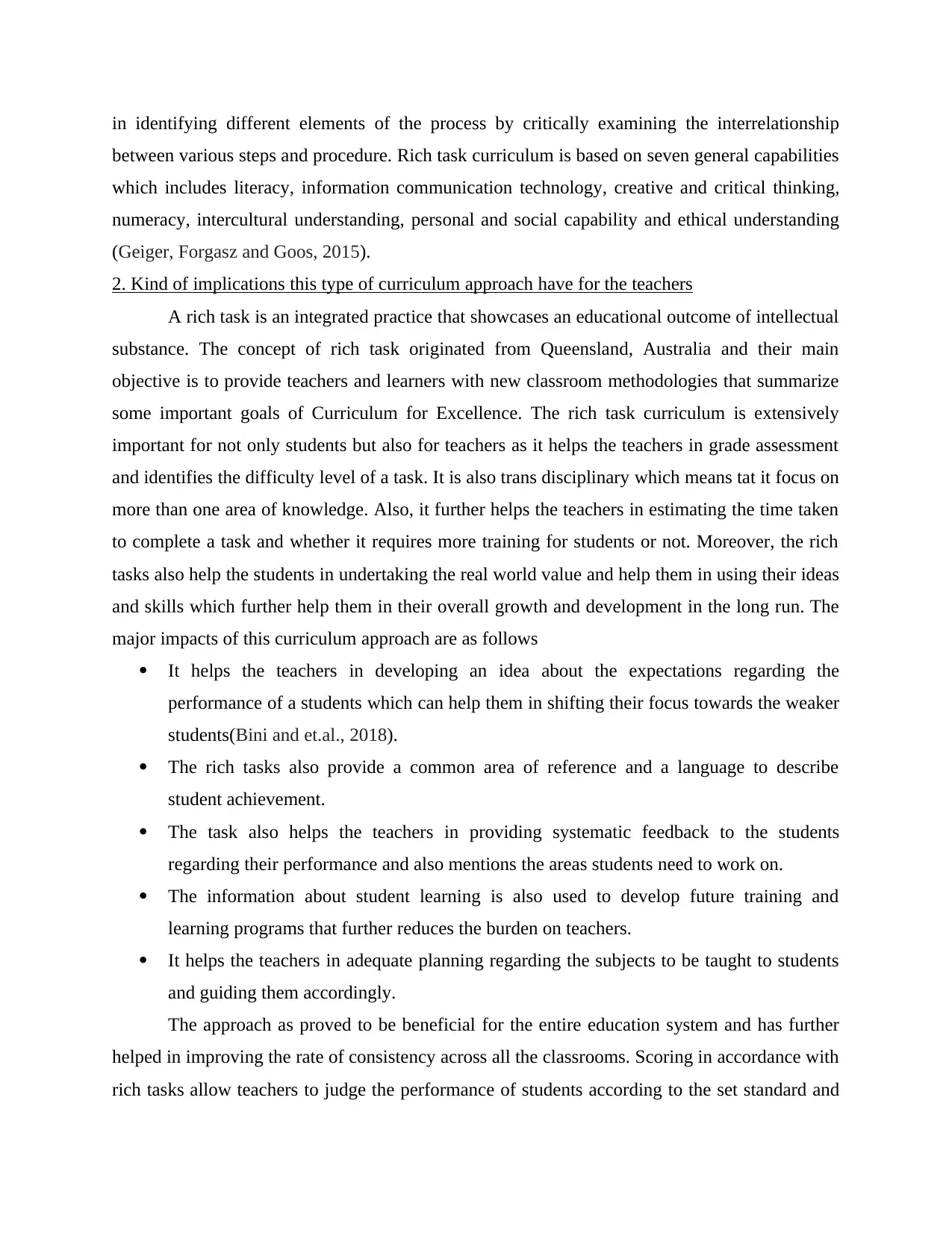
in identifying different elements of the process by critically examining the interrelationship
between various steps and procedure. Rich task curriculum is based on seven general capabilities
which includes literacy, information communication technology, creative and critical thinking,
numeracy, intercultural understanding, personal and social capability and ethical understanding
(Geiger, Forgasz and Goos, 2015).
2. Kind of implications this type of curriculum approach have for the teachers
A rich task is an integrated practice that showcases an educational outcome of intellectual
substance. The concept of rich task originated from Queensland, Australia and their main
objective is to provide teachers and learners with new classroom methodologies that summarize
some important goals of Curriculum for Excellence. The rich task curriculum is extensively
important for not only students but also for teachers as it helps the teachers in grade assessment
and identifies the difficulty level of a task. It is also trans disciplinary which means tat it focus on
more than one area of knowledge. Also, it further helps the teachers in estimating the time taken
to complete a task and whether it requires more training for students or not. Moreover, the rich
tasks also help the students in undertaking the real world value and help them in using their ideas
and skills which further help them in their overall growth and development in the long run. The
major impacts of this curriculum approach are as follows
It helps the teachers in developing an idea about the expectations regarding the
performance of a students which can help them in shifting their focus towards the weaker
students(Bini and et.al., 2018).
The rich tasks also provide a common area of reference and a language to describe
student achievement.
The task also helps the teachers in providing systematic feedback to the students
regarding their performance and also mentions the areas students need to work on.
The information about student learning is also used to develop future training and
learning programs that further reduces the burden on teachers.
It helps the teachers in adequate planning regarding the subjects to be taught to students
and guiding them accordingly.
The approach as proved to be beneficial for the entire education system and has further
helped in improving the rate of consistency across all the classrooms. Scoring in accordance with
rich tasks allow teachers to judge the performance of students according to the set standard and
between various steps and procedure. Rich task curriculum is based on seven general capabilities
which includes literacy, information communication technology, creative and critical thinking,
numeracy, intercultural understanding, personal and social capability and ethical understanding
(Geiger, Forgasz and Goos, 2015).
2. Kind of implications this type of curriculum approach have for the teachers
A rich task is an integrated practice that showcases an educational outcome of intellectual
substance. The concept of rich task originated from Queensland, Australia and their main
objective is to provide teachers and learners with new classroom methodologies that summarize
some important goals of Curriculum for Excellence. The rich task curriculum is extensively
important for not only students but also for teachers as it helps the teachers in grade assessment
and identifies the difficulty level of a task. It is also trans disciplinary which means tat it focus on
more than one area of knowledge. Also, it further helps the teachers in estimating the time taken
to complete a task and whether it requires more training for students or not. Moreover, the rich
tasks also help the students in undertaking the real world value and help them in using their ideas
and skills which further help them in their overall growth and development in the long run. The
major impacts of this curriculum approach are as follows
It helps the teachers in developing an idea about the expectations regarding the
performance of a students which can help them in shifting their focus towards the weaker
students(Bini and et.al., 2018).
The rich tasks also provide a common area of reference and a language to describe
student achievement.
The task also helps the teachers in providing systematic feedback to the students
regarding their performance and also mentions the areas students need to work on.
The information about student learning is also used to develop future training and
learning programs that further reduces the burden on teachers.
It helps the teachers in adequate planning regarding the subjects to be taught to students
and guiding them accordingly.
The approach as proved to be beneficial for the entire education system and has further
helped in improving the rate of consistency across all the classrooms. Scoring in accordance with
rich tasks allow teachers to judge the performance of students according to the set standard and
Paraphrase This Document
Need a fresh take? Get an instant paraphrase of this document with our AI Paraphraser
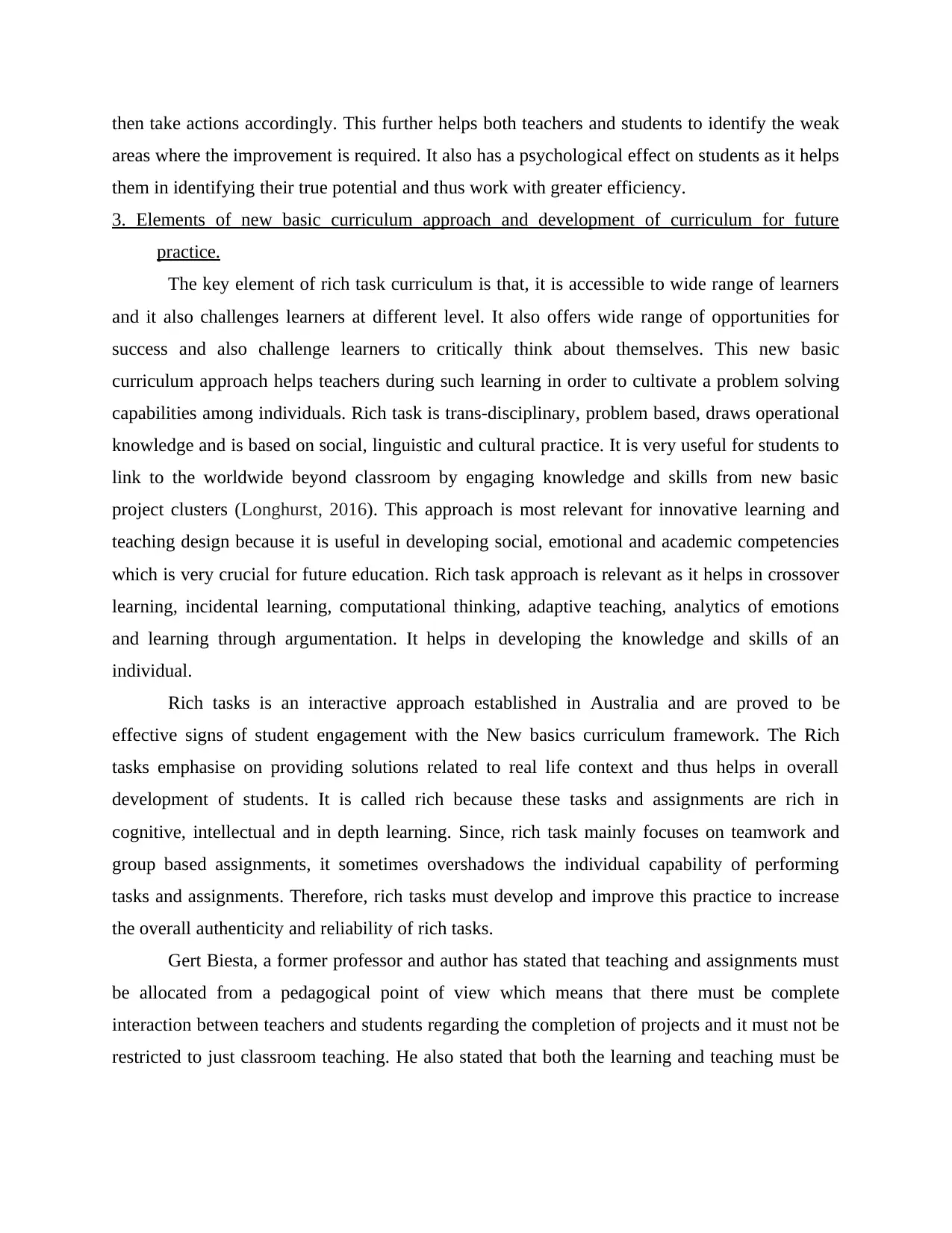
then take actions accordingly. This further helps both teachers and students to identify the weak
areas where the improvement is required. It also has a psychological effect on students as it helps
them in identifying their true potential and thus work with greater efficiency.
3. Elements of new basic curriculum approach and development of curriculum for future
practice.
The key element of rich task curriculum is that, it is accessible to wide range of learners
and it also challenges learners at different level. It also offers wide range of opportunities for
success and also challenge learners to critically think about themselves. This new basic
curriculum approach helps teachers during such learning in order to cultivate a problem solving
capabilities among individuals. Rich task is trans-disciplinary, problem based, draws operational
knowledge and is based on social, linguistic and cultural practice. It is very useful for students to
link to the worldwide beyond classroom by engaging knowledge and skills from new basic
project clusters (Longhurst, 2016). This approach is most relevant for innovative learning and
teaching design because it is useful in developing social, emotional and academic competencies
which is very crucial for future education. Rich task approach is relevant as it helps in crossover
learning, incidental learning, computational thinking, adaptive teaching, analytics of emotions
and learning through argumentation. It helps in developing the knowledge and skills of an
individual.
Rich tasks is an interactive approach established in Australia and are proved to be
effective signs of student engagement with the New basics curriculum framework. The Rich
tasks emphasise on providing solutions related to real life context and thus helps in overall
development of students. It is called rich because these tasks and assignments are rich in
cognitive, intellectual and in depth learning. Since, rich task mainly focuses on teamwork and
group based assignments, it sometimes overshadows the individual capability of performing
tasks and assignments. Therefore, rich tasks must develop and improve this practice to increase
the overall authenticity and reliability of rich tasks.
Gert Biesta, a former professor and author has stated that teaching and assignments must
be allocated from a pedagogical point of view which means that there must be complete
interaction between teachers and students regarding the completion of projects and it must not be
restricted to just classroom teaching. He also stated that both the learning and teaching must be
areas where the improvement is required. It also has a psychological effect on students as it helps
them in identifying their true potential and thus work with greater efficiency.
3. Elements of new basic curriculum approach and development of curriculum for future
practice.
The key element of rich task curriculum is that, it is accessible to wide range of learners
and it also challenges learners at different level. It also offers wide range of opportunities for
success and also challenge learners to critically think about themselves. This new basic
curriculum approach helps teachers during such learning in order to cultivate a problem solving
capabilities among individuals. Rich task is trans-disciplinary, problem based, draws operational
knowledge and is based on social, linguistic and cultural practice. It is very useful for students to
link to the worldwide beyond classroom by engaging knowledge and skills from new basic
project clusters (Longhurst, 2016). This approach is most relevant for innovative learning and
teaching design because it is useful in developing social, emotional and academic competencies
which is very crucial for future education. Rich task approach is relevant as it helps in crossover
learning, incidental learning, computational thinking, adaptive teaching, analytics of emotions
and learning through argumentation. It helps in developing the knowledge and skills of an
individual.
Rich tasks is an interactive approach established in Australia and are proved to be
effective signs of student engagement with the New basics curriculum framework. The Rich
tasks emphasise on providing solutions related to real life context and thus helps in overall
development of students. It is called rich because these tasks and assignments are rich in
cognitive, intellectual and in depth learning. Since, rich task mainly focuses on teamwork and
group based assignments, it sometimes overshadows the individual capability of performing
tasks and assignments. Therefore, rich tasks must develop and improve this practice to increase
the overall authenticity and reliability of rich tasks.
Gert Biesta, a former professor and author has stated that teaching and assignments must
be allocated from a pedagogical point of view which means that there must be complete
interaction between teachers and students regarding the completion of projects and it must not be
restricted to just classroom teaching. He also stated that both the learning and teaching must be
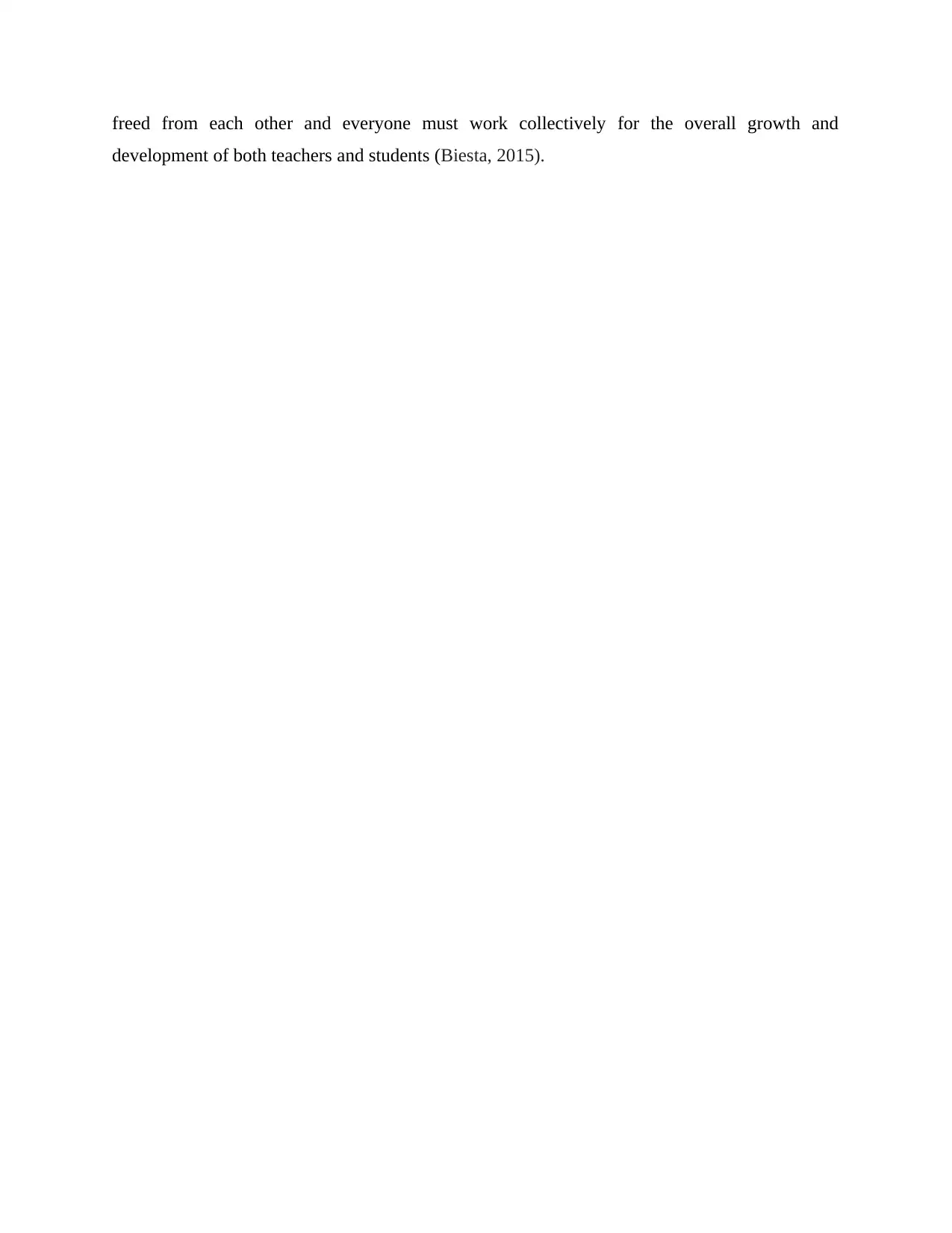
freed from each other and everyone must work collectively for the overall growth and
development of both teachers and students (Biesta, 2015).
development of both teachers and students (Biesta, 2015).
⊘ This is a preview!⊘
Do you want full access?
Subscribe today to unlock all pages.

Trusted by 1+ million students worldwide
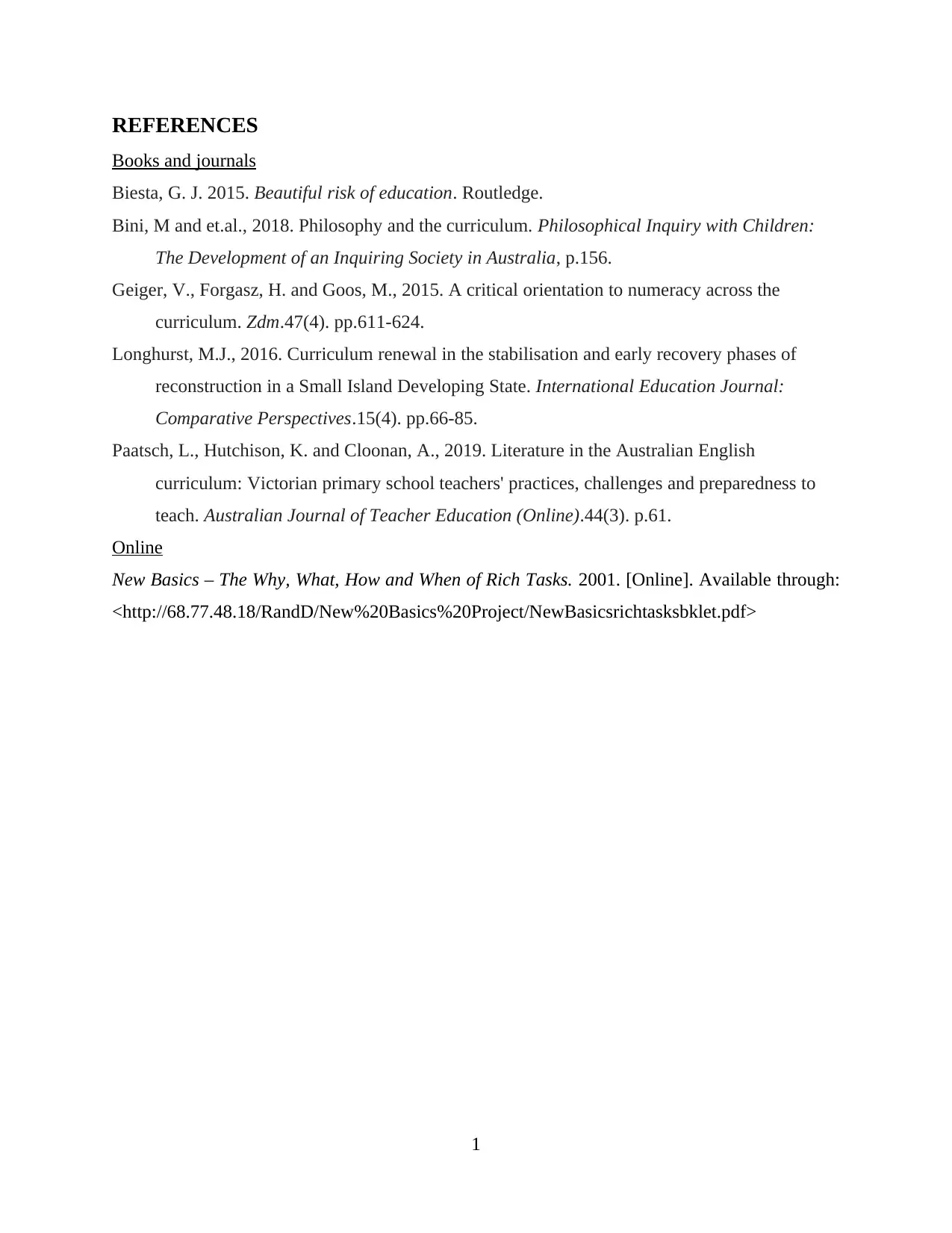
REFERENCES
Books and journals
Biesta, G. J. 2015. Beautiful risk of education. Routledge.
Bini, M and et.al., 2018. Philosophy and the curriculum. Philosophical Inquiry with Children:
The Development of an Inquiring Society in Australia, p.156.
Geiger, V., Forgasz, H. and Goos, M., 2015. A critical orientation to numeracy across the
curriculum. Zdm.47(4). pp.611-624.
Longhurst, M.J., 2016. Curriculum renewal in the stabilisation and early recovery phases of
reconstruction in a Small Island Developing State. International Education Journal:
Comparative Perspectives.15(4). pp.66-85.
Paatsch, L., Hutchison, K. and Cloonan, A., 2019. Literature in the Australian English
curriculum: Victorian primary school teachers' practices, challenges and preparedness to
teach. Australian Journal of Teacher Education (Online).44(3). p.61.
Online
New Basics – The Why, What, How and When of Rich Tasks. 2001. [Online]. Available through:
<http://68.77.48.18/RandD/New%20Basics%20Project/NewBasicsrichtasksbklet.pdf>
1
Books and journals
Biesta, G. J. 2015. Beautiful risk of education. Routledge.
Bini, M and et.al., 2018. Philosophy and the curriculum. Philosophical Inquiry with Children:
The Development of an Inquiring Society in Australia, p.156.
Geiger, V., Forgasz, H. and Goos, M., 2015. A critical orientation to numeracy across the
curriculum. Zdm.47(4). pp.611-624.
Longhurst, M.J., 2016. Curriculum renewal in the stabilisation and early recovery phases of
reconstruction in a Small Island Developing State. International Education Journal:
Comparative Perspectives.15(4). pp.66-85.
Paatsch, L., Hutchison, K. and Cloonan, A., 2019. Literature in the Australian English
curriculum: Victorian primary school teachers' practices, challenges and preparedness to
teach. Australian Journal of Teacher Education (Online).44(3). p.61.
Online
New Basics – The Why, What, How and When of Rich Tasks. 2001. [Online]. Available through:
<http://68.77.48.18/RandD/New%20Basics%20Project/NewBasicsrichtasksbklet.pdf>
1
Paraphrase This Document
Need a fresh take? Get an instant paraphrase of this document with our AI Paraphraser

2
1 out of 8
Related Documents
Your All-in-One AI-Powered Toolkit for Academic Success.
+13062052269
info@desklib.com
Available 24*7 on WhatsApp / Email
![[object Object]](/_next/static/media/star-bottom.7253800d.svg)
Unlock your academic potential
Copyright © 2020–2025 A2Z Services. All Rights Reserved. Developed and managed by ZUCOL.




